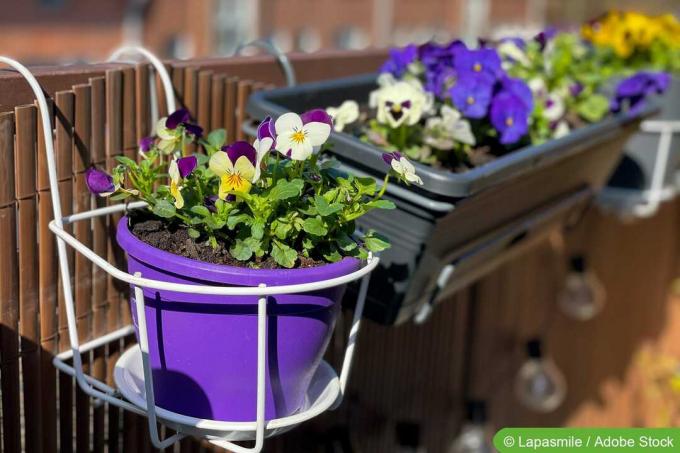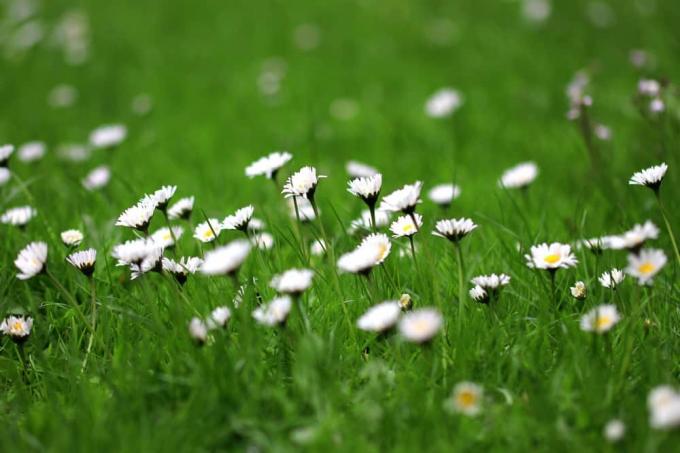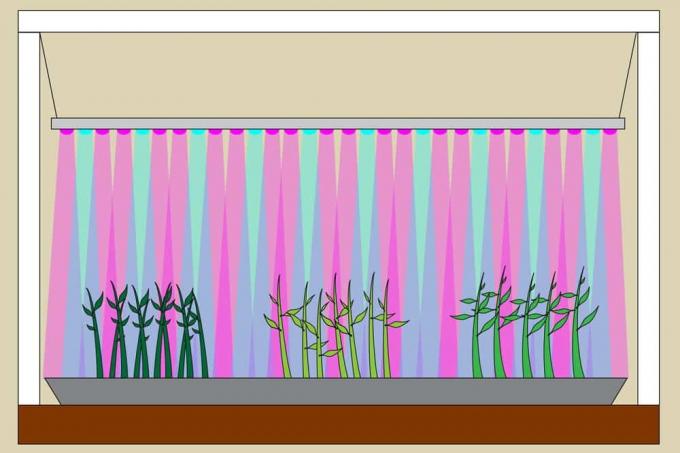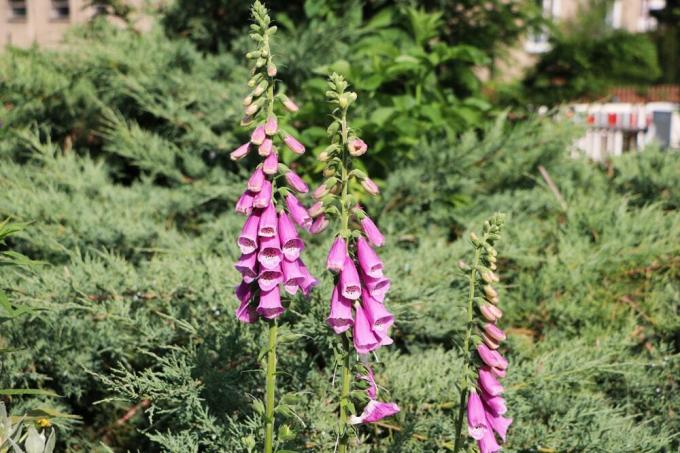

Table of contents
- The perfect time
- Only plant clean containers
- Proper stratification when planting
- Proper placement of potted plants
- Pour right
- Equip thirsty plants with an automatic watering system
- Select the right plants for the bucket
- frequently asked Questions
- Popular plants for the garden and balcony boxes
Plants in boxes - quite a few plants can be kept in appropriate planters both in the garden and on the balcony. The balcony and garden design can be implemented with relatively little effort and you also remain flexible thanks to the mobility of the pots.
The perfect time
If you want to have beautiful plants in the garden and on the balcony in planters throughout the summer, you should plant at the right time. You shouldn't be impatient, because plants that are brought outside too early may still get night frosts in spring and then die. May is the right time to start planting pots for the garden and balcony without having to take the plants back inside at night. Incidentally, daisies, begonias and geraniums in particular are just as popular plants in tubs as they are sensitive plants when it comes to cold temperatures.
Tip:
If you want to be absolutely sure and possibly even want to use relatively sensitive plants, wait until the ice saints before the Tubs are then finally planted, because up to this point in time around mid-May, night frosts can still occur in our regions.
Only plant clean containers
Before the tubs are planted, they should be thoroughly cleaned. A hand brush is suitable for removing coarse dirt. After the planter has been freed from the coarse dirt, a damp cloth is used for the final cleaning. Some containers that have already been planted have relatively stubborn limescale deposits. You can use a wire brush to remove them. Alternatively, the plant pot affected by lime deposits is placed in a water bath to which vinegar or citric acid has been added. In this way, even heavy limescale stains can be easily removed.
Proper stratification when planting
When placing any plants in tubs, it is important that they are protected from waterlogging. Some plants react very strongly sensitive to waterlogging and die, in any case unwanted waterlogging affects healthy plants in all plants Growth. The first layer when the substrate is placed in the tub is therefore a layer of expanded clay, which absorbs the excess water and keeps it away from the sensitive roots. The advantage of expanded clay is also that it slowly releases the stored water back to the earth, especially on hot days.
A separating fleece is laid over the drainage layer so that the soil that is then filled in is not washed into the drainage layer of expanded clay. Only now is the right potting soil poured into the planter. It is good to work in a long-term fertilizer, such as compost, as soon as you fill the container with soil. This ensures a continuous supply of nutrients to the plant, which ensures continuous and powerful flowering. As an alternative to compost, horn shavings, which are available in hardware stores or garden centers, can also be worked into the soil. If you take precautions like this, you no longer have to worry about fertilizing the plants throughout the season. Layering the substrate correctly means...
- first drainage from expanded clay
- then a separating fleece
- then pour potting soil interspersed with long-term fertilizer into the bucket
Proper placement of potted plants
Before the plants are placed in the pots, they are removed from the plastic cups in which they were purchased. To do this, the cup is grasped and then squeezed in some places. This is how the root ball comes out of the cup without damaging the delicate root ramifications. Now the stalk of the plant is taken between two fingers and covered with the hand. Then the plant is turned and released from the cup with a slight pull. If the root balls are already heavily matted, they must first be carefully plucked apart. This is important so that the plant later roots perfectly in the substrate. If the plants are in the right place in the container, the gaps are filled with soil, which in turn is lightly pressed down. It is important that there is still about two centimeters of space for the irrigation water from the top edge of the soil to the bottom edge of the bucket so that the bucket does not always overflow.
Pour right
While bedding plants can build up a water supply in the soil through intensive watering, potted plants for the garden and balcony need more tact. Especially during the growing season in summer, the potted plants must be watered moderately but regularly. Watering in the morning and in the evening is best, because the water will seep in when the temperatures are a little cooler soil, while in the hot midday hours it evaporates immediately on the surface of the earth and not to the roots reached. Soft and low-lime water is perfect, preferably from a rain barrel. Potted plants may only be poured onto the ground, but not over leaves and flowers
Tip:
Always water potted plants slowly. Then you can absorb the water well from the dried soil, while it runs through the dry soil directly into the drainage with quick watering.
Equip thirsty plants with an automatic watering system
Special planters are equipped with a double bottom and therefore have a water reservoir for the plant. Equipped with a water level indicator, the bucket shows when it is time to water again. Alternatively, you can buy special containers that, when filled with water and placed in the soil, release the water sporadically to the substrate. In addition, special flower boxes are commercially available which, in addition to the double bottom, also have a side filler neck over which they are poured. Incidentally, these tubs do not have to be provided with drainage before planting. Clay pots are also very good as planters, because they soak up water and gradually release it to the plant. A quick and inexpensive solution are water bottles made of plastic, which are filled with water and placed upside down in the substrate. With this solution, the plant can easily be supplied with water for about a week without further watering - this watering is also ideal for shorter trips.
Select the right plants for the bucket
There are a wide variety of plants that can be planted in tubs and kept in the garden or on the balcony. First of all, the location of the garden or balcony is important for the selection, because that decides whether it is more likely sun-hungry plants or whether more robust plants that get by with less sun can be placed in the tub can become. Incidentally, both garden herbs and intentionally small bred vegetable and fruit plants, which are decorative when kept in a bucket and at the same time promise a harvest, are becoming increasingly popular. It is also important to consider the influence of the sun on the plants and their needs. Those who are more shady should rely on plants such as ivy, fuchsias, primroses or boxwood and chrysanthemums. On the other hand, fruits and herbs, vegetables such as tomatoes or geraniums, dahlias or petunias tolerate a lot of sun.
frequently asked Questions
In general, the plant should be overwintered according to its individual needs in terms of light conditions, room temperature and care. It is important for all potted plants that they are freed from leaves, weeds and possible pests before they are sent to hibernate. Withered flowers, diseased areas and dead wood are also removed before overwintering. This is the only way for the plant to get through the cold season healthy and strong.
In addition to good care that strengthens the plant, many hobby gardeners also swear by an infusion also horsetail, which gives the plants strength and protects them from pests and diseases protects.
Popular plants for the garden and balcony boxes
- Buddleia: The fragrant butterfly magnet is swarmed by butterflies of all kinds. Many varieties in blue, white and purple. Buddleia is suitable for the vase.
- sun bride: In numerous shades of yellow, orange and red, this flowering wonder, which grows to a height of around 100 to 140 cm, provides color from August. The sun bride is one of the most important color pillars in the autumn garden. Despite her name, the North American prefers adequate moisture.
- sunflower: If you have a larger area available, you should sow the man-high sun worshipers at different times so that the vase always has new flowers.
- coneflower: A safe entry-level perennial that you can’t go wrong with. The crimson flower stars adorn beds and vases. Attractive infructescence.
- flame flower: The upright decorative perennial is the right flower material for representative beds. Varieties in white, pink and red grow up to 150 cm high. Ideal neighbors are chrysanthemums.
- blue diamond: Already in the first garden year a blue miracle. The blue rue attracts many insects and, with its gray felty foliage, goes well with roses. Prefers sunny, bright locations.
- splendor spars: Astilbes love semi-shady locations. The wetter the soil, the more direct sun they get. White, red and pink varieties offer a rich choice for every taste. the finely feathered foliage underlines the graceful character of this border perennial.
- dahlias: The selection of dahlia varieties is gigantic. They bloom reliably in any weather. In contrast to the many other spring-flowering bulbs and bulbs, dahlias shine with many flowers in autumn.
- Autumn Anemones: Excellent autumn bloomers for partially shaded locations. They also fit very well between trees and spread highlights even in northern locations. Autumn anemones grow to about 100 cm in height. They bloom in many shades of pink and white until the first frost.
- chrysanthemums: Well-known cottage garden perennials that stage a late blossom festival in red, yellow and pink with large flower plates in bright colors. Prefers sunny locations.
 garden editorial
garden editorial I write about everything that interests me in my garden.
Learn more about grooming

send plants | 7 tips for sending flowers
Sending plants requires good preparation. Not only the type of packaging is of great importance, so that the goods arrive safely at their destination. The season is also important. It depends on how well the plants survive the transport.

30 office plants for a better indoor climate
A bit of green in the office not only looks pretty, but can also significantly improve the indoor climate. For example, indoor plants increase humidity, can clean the air and, if they are large enough, even dampen noise.

21 edible flowers | What flowers can you eat?
Edible flowers can be used for many dishes in the kitchen, not just as decoration. The flavors range from sugary-sweet to peppery-spicy and give food and drinks a very special touch.

Everything about LED plant lights: Build plant lights yourself
Plants need light. In the absence of it, they suffer or perish. Sometimes, conventional daylight just isn't enough to meet a plant's light needs. Then LED plant lighting can help. How to build such a plant light yourself is here.

Shade plants: 17 green and flowering plants for the shade
Shady garden areas are a challenge for every hobby gardener, although shade does not mean that it is completely dark. Partial shadow and light shadow are also a type of shadow. The range of suitable plants is growing steadily and offers a variety of design options.

Forest flowers: 55 flowering species in the forest sorted by color
When the local forests dress in picturesque shades of color throughout the year, the numerous forest flowers in Germany present themselves and inspire with their blaze of colour. From purple to red to white and yellow, the German forests have a lot to offer.


